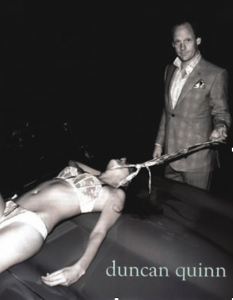
This photograph was taken from the 2008 advertising campaign for Duncan Quinn, a luxury, high-end suit maker who entices the wealthy through their own ideologies of man. They advertise a swish, wealthy lifestyle that only the elite can afford, through fast cars, fine suits and dominance over women. On the Duncan Quinn website, he is described to “ throw the occasional party, indulge in the odd cheeky lunch, drive too fast and enjoy life just a little too much in the company of his friends”. He takes aspects of his own life and uses it as influences of how he wants his own brand to be represented and who his target audiences is, raising the concern of ethical and social issues within the advertising industry.
The image depicts a bloody, half naked women, lying on the top of a car while the man stands over her looking smug. The fact that he is fully clothed in an expensive suit while she is half-naked with a tie around her neck, embodies animalistic connotations, dehumanising her, making her submissive in comparison. In addition, he is stood over her which implies that he is ‘above’ her in superiority. The use of the neck tie is typically a symbol of power which is taken further here as it is the main weapon that is used by the ‘anti-hero’. This arises the social issue of masculinity. Jason Katz wrote, Advertising and the Construction of Violent White Masculinity where he explores the dominant aspects of being white, heterosexual and middle class within a patriarchal society, for example, “Dealing with economic instability, the increased amount of non-White workers taking jobs, and the women’s movement, men of the time were looking to something that they could use: strength and violence.” This way of understanding, applies to Duncan Quinns ethos and how he represents his own company. He appeals to the white, heterosexual man because that is what his company embodies, it is a projection of Duncans own out-dated views and morals which can be seen to be foreshadowed within this image, through the black and white filter used over the top.
Another ethical issue that has been raised from this advertising campaign is how women’s bodies are exploited to generate male attention. Theorist, Laura Mulvey discussed the male gaze in exccess which can be applied to this image. The fact that a women has been used half naked, stretched over a car, in ‘sexy underwear’ denies her of human identity, which is emphasised by the fact that her face isn’t used in the image, only her body. Laura Mulvey expressed, “In a world ordered by sexual imbalance, pleasure in looking has been split between active male and passive female” which is illustrated within the relationship of the two protagonists in the image.
I personally believe that the progress made by the feminist movement is being contradicted by the ideologies presented by elite brands who embody out-dated, offensive and morbid ideologies showing that there is still a huge divide within the advertising industry and what is socially acceptable within today’s society.
Kratz, J (2011). Advertising and the Construction of Violent White Masculinity. (SECOND EDITION) Thousand Oaks, pp. 261-269.
Mulvey, L (2009). Visual and other pleasure. Basingstoke: Palgrave Macmillan.
Dunca Quinn (2011) Who?. avaliable from: http://duncanquinn.com/about/ [Accessed 27 November 2017].
University of Pittsburgh (2014) Advertising and Dominant Masculinity | Gender, Sexuality, and Women’s Studies. Avaliable from: http://www.wstudies.pitt.edu/blogs/mnf14/advertising-and-dominant-masculinity [Accessed 27 November 2017].
